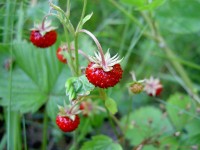Dr. Assaf Aharoni and Dr. Avital Adato, from the Department of Plant Sciences at the Weizmann Institute of Science, are the only Israeli researchers who participated in the project, and contributed to the research the mapping and identification of genes and gene families that are responsible for creating the taste and smell of the strawberry

A joint effort of 74 scientists from 38 research institutions around the world, recently led to the determination of the complete genetic sequence of the wild strawberry and its decipherment. The research is published today in the scientific journal Nature Genetics. Dr. Assaf Aharoni and Dr. Avital Adato, from the Department of Plant Sciences at the Weizmann Institute of Science, are the only Israeli researchers who participated in the project, and contributed to the research the mapping and identification of genes and gene families that are responsible for creating the taste and smell of the strawberry.
The wild strawberry (woodland strawberry, or in its Latin name Fragaria vesca) is a close relative of the cultivated and well-known garden strawberry. The fruits contain a large amount of antioxidants (mainly from the tannin family - the substances also found in wine and create the astringency), as well as vitamins A, C and B12, and minerals such as potassium, calcium and magnesium. In addition, the strawberry fruit is unique in that it is very rich in flavor and aroma substances.
For Dr. Aharoni, the participation in the international research is the closing of a circle: for many years he has been researching the metabolic pathways in which the taste and smell substances are formed during the ripening of the strawberry fruit. Dr. Aharoni was one of the first to use biological chips for genetic analysis of plants, and identified genes that play a role in the creation of flavoring substances in strawberries. His research compares the flavor and aroma substances found in wild strawberries, and those found in cultivated strawberries, and traces the genetic reasons for these differences. decoding
The complete genome of the wild strawberry allows him to investigate in a more thorough and comprehensive way the many genes involved in the process, and also sheds new light on some of his past findings. Thus, for example, with the help of a computerized analysis of the wild strawberry genome, Dr. Adato has now discovered that only a relatively small family of enzymes, one of which was previously characterized by Dr. Aharoni, is responsible for the creation of a large group of approximately one hundred aroma substances, the way in which they are created was not fully clear.
Dr. Aharoni hopes that the new information will help, among other things, to understand how it is possible to restore to garden strawberries the taste and aroma that they have lost over the years. The wild strawberries that have just been mapped - which have a concentrated and particularly strong flavor and aroma - can certainly be an example to be aspired to.
The wild strawberry joins a series of plants whose genomes have been decoded and mapped in their entirety - such as rice, grapes and soybeans. The mapping shows that the total length of the genome is about 240 million bases, and there are about 35,000 genes (for comparison, the human genome includes about three billion bases, and about 23,000 genes). The genome of the wild strawberry is simple and relatively short, the plant is easy and convenient to grow and genetically induce, and it has a short life cycle. For these reasons, it can be used as a model for other plants of agricultural and economic importance that also belong to the rose family, which are less convenient for research: the garden strawberry, and trees such as apples, peaches, cherries, almonds and more.
More of the topic in Hayadan:

8 תגובות
So this means that maybe one day we will also be able to eat white strawberries in Israel
(http://www.fraisesdesbois.com/)
I ate these in Tasmania (or a variety similar to the one on the site) and these were the tastiest strawberries I've ever eaten.
Shlomo, your site looks and sounds simply lovely, good luck.
(There is nothing like strawberries with whipped cream, and bananas, the most delicious and natural delicacy)
In northern Italy in the Dolomites, I saw a wild strawberry, which of course won the photo.
You can see the picture on my website: www.atzmonis.com
please:
http://www.youtube.com/watch?v=WTWA2ACaP_s
As long as we have plain white sugar, no fruit will be sweet. It has already been said before that sweetness is a matter of habit. As we have more sweet consumer products, the fruits become "boring" in taste, even though they themselves are as sweet as they have been all these years.
Strawberry in chocolate is considered a delicacy,
The genome of the cocoa fruit has long been deciphered,
Now we will wait for them to add the strawberries to the cocoa
And we can eat chocolate!
The time has come to decode the genome of oranges and restore the sweetness that they had in the past and that was lost.
Finally something beautiful and aesthetic on the site.
Such a heartwarming picture.